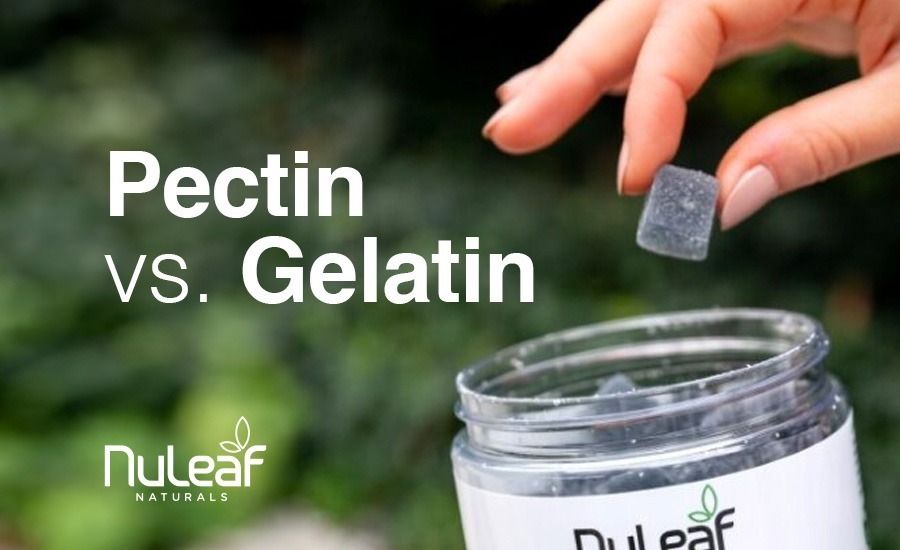Pectin vs. Gelatin

When it comes to the world of gummies, two terms often pop up: pectin and gelatin. These two substances are the backbone and a common ingredient in many of our favorite treats and candies, from the classic gummy bear to the increasingly popular CBD gummies. But what are they, and how do they differ?
What is Pectin?
Pectin is a naturally occurring polysaccharide that plays a crucial role in the structure and texture of many foods. It’s primarily found in the cell walls of plants, with the highest concentrations present in citrus fruits, specifically citrus peels and apple pulp. When these fruits are cooked with sugar, pectin helps to give jams and jellies their characteristic thick and spreadable consistency.
There are two main types of pectin: high-methoxyl (HM) and low-methoxyl (LM). HM pectins require sugar and acid to gel, making them ideal for traditional jam and jelly recipes. LM pectins, on the other hand, can gel with calcium, allowing for reduced-sugar or sugar-free recipes.
One of the standout features of pectin is its plant-based origin. This makes it a preferred choice for vegans, vegetarians, and those looking for halal or kosher gelling agents. Its natural derivation also means it’s free from the ethical concerns that some people have regarding animal-derived products.
What is Gelatin?
Gelatin, in contrast to pectin, is an animal-derived protein. It’s obtained by boiling certain animal parts, specifically the skin, bones, connective tissues, ligaments, and cartilage, usually from cows or pigs. This process breaks down the collagen in these parts, resulting in a mixture that, when cooled, forms a gel.
The wobbly texture of many desserts, most notably Jello, is thanks to gelatin. It’s also used in various other culinary applications, from marshmallows to certain types of whipped cream and even some yogurts.
There are two primary forms of gelatin: Type A and Type B. Their difference is in their production method and isoelectric point (pH measure). Type A gelatin is derived from acid-cured tissue and has a slightly different protein composition than Type B, which comes from lime-cured tissue.
While both types have similar culinary applications, their differing properties can make one more suitable than the other depending on the specific use.
Pectin vs. Gelatin in Gummies
Both pectin and gelatin play pivotal roles in the gummy world, including in the production of CBD and THC gummies. However, they bring distinct characteristics to the table:
Vegan-Friendliness
Pectin wins, hands down. Being plant-derived, it’s a favorite for vegans, while gelatin’s animal origins make it unsuitable for such diets.
Consistency and Texture
Pectin offers a softer, spreadable texture with a clean bite. In contrast, gelatin provides that classic elastic and chewy feel many associate with traditional gummies.
Heat Reactivity
Pectin demands higher heat during production to achieve its gel-like consistency, which remains stable at room temperature. Gelatin, however, can turn into liquid if exposed to high temperatures.
Taste
Pectin is the neutral player, rarely influencing the final product’s taste. Gelatin can sometimes introduce an animal-like taste, especially in larger quantities.
Time to Set
If you’re in a hurry, pectin is your friend, setting within minutes. Gelatin, however, asks for patience, taking up to a full day to set.
Choosing Between Pectin and Gelatin-Based Gummies
The choice between pectin and gelatin is pivotal in the world of CBD and THC gummies. Pectin, a plant-derived agent, is a vegan favorite, contrasting with gelatin’s animal-based origins. Specifically, the most frequently used type of gelatin is pork-based. Texture-wise, pectin offers a soft, clean bite, while gelatin brings a classic chewiness. Pectin provides higher clarity without added supplements, meaning gummies can have vibrant colors with less added dye.
During production, pectin needs higher heat but remains stable at room temperature, ensuring the gummies maintain their shape even in direct sunlight. In contrast, gelatin has thermoreversibility, meaning it can be remelted if a mistake occurs during the gummy-making process. However, this feature also means gelatin gummies might melt if left in a hot car.
Taste-wise, pectin is neutral, letting the gummy’s flavor stand out. In contrast, gelatin might introduce a subtle animal-like aftertaste, especially if it dominates the ingredient list. Interestingly, combining pectin with gelatin can offer the best of both worlds: gelatin’s texture with pectin’s heat resistance.
And for those making gummies, pectin sets quickly, often in minutes, and can be demolded in as little as 30 minutes, followed by a drying process to achieve the perfect consistency. Gelatin, on the other hand, tests your patience, taking its sweet time—sometimes up to a day—to set.
For those seeking vegan-friendly options or a cleaner taste, pectin is the way to go. However, gelatin might be your pick if you’re nostalgic for that traditional gummy chewiness and aren’t concerned about the occasional melt.
Buy Vegan-Friendly CBD Gummies Online
Understanding the differences between pectin and gelatin is crucial when choosing or making gummies. Whether you prioritize vegan-friendly ingredients or a specific texture, knowing these differences ensures you make an informed choice.
If you’re searching for high-quality, vegan-friendly CBD gummies and THC Gummies, look no further than NuLeaf Naturals. We proudly use pectin in our gummies, ensuring you get a product that aligns with your values.
Shop now and experience the difference for yourself!